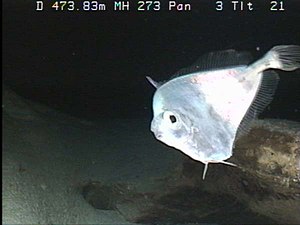Grammicolepis brachiusculus
| Grammicolepis brachiusculus | ||||||||||||
|---|---|---|---|---|---|---|---|---|---|---|---|---|

Grammicolepis brachiusculus , image from an ROV |
||||||||||||
| Systematics | ||||||||||||
|
||||||||||||
| Scientific name of the genus | ||||||||||||
| Grammicolepis | ||||||||||||
| Poey , 1873 | ||||||||||||
| Scientific name of the species | ||||||||||||
| Grammicolepis brachiusculus | ||||||||||||
| Poey, 1873 |
Grammicolepis brachiusculus is a marine fish from the order of the St. Peter's fish-like (Zeiformes). It occurs in the eastern Atlantic from Spain across the Gulf of Guinea south to South Africa ( Durban ), in the western Atlantic from the Georges Bank east from Cape Cod to Suriname , in the northern Pacific from Japan to Hawaii and in the Mediterranean. The fish lives at depths of 300 to 1025 meters, most specimens have been detected at depths of 500 to 700 meters. Due to the deep habitat in the mesopelagial often near the sea floor, its way of life is largely unknown.
features
Grammicolepis brachiusculus becomes a maximum of 65 cm long and has a laterally flattened, oval body. The fish are silvery. Young fish have irregular black spots on the body and caudal fin and 4 or 5 black stripes on the anal fin. Of the two dorsal fins, the first is supported by six to seven spines, the second by 32 to 34 soft rays. The anal fin has two isolated short fin spines and 33 to 35 soft rays. Gill rakes are only rudimentary.
Adult specimens are at least twice as long as they are tall, juveniles with a length of less than 20 cm are much higher back and their length is 1.4 to 1.6 times the body height. The head length is about a third of the standard length , while the head length in adult specimens is only a quarter of the standard length. Young fish up to a size of 24 cm have 10 to 11 spiny, horizontally flattened scales on the body and tail, and 34 to 36 spiny outgrowths at the base of the dorsal fin. During metamorphosis , which takes place at a length of 25 to 30 cm, the body becomes more elongated, the prickly scales disappear and the prickly outgrowths on the dorsal fin membrane base are greatly reduced.
supporting documents
- ↑ a b c P.C. Heemstra: Grammicolepidae Tinselfishes. Pages 1214 to 1216 in FAO Species Identification guide for Fishery Purposes: The Living Marine Resources of the Western Central Atlantic, Volume 2 Bony fishes part 1 (Acipenseridae to Grammatidae) , ISBN 92-5-104825-8
- ↑ a b c Grammicolepis brachiusculus on Fishbase.org (English)
